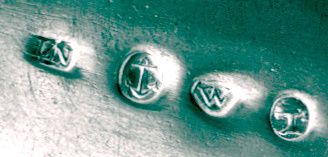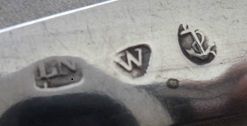Dear Dognose
Greenock marks do not have a fouled anchor otherwise you would be correct. I have been in contact with RT.
Thx
Grianaig
Scot Prov Spoon; Anchor Mark
Re: Scot Prov Spoon; Anchor Mark
Hi Grianaig,
As far as the above goes, I'm only using Greenock as an example, other provincial towns that did have their own guilds, were perhaps on a more formal footing as the use of certain symbols and devices. There is still a mountain of research to be done on Scottish provincial marking, and the towns that do not having surviving guild records will, no doubt, prove to be the most difficult.
So, always keep an open mind when researching unofficial marks, and never say never.
Trev.
I never said it was Greenock, I just noted previous attributions to the closest sets of marks that I could find for you. But do not be inflexible as to some attributions, they are not written in stone. Greenock, for example, did not have a guild of hammermen and the town's coat of arms do not appear to contain an anchor. Several devices were used by the silversmiths in that town, including the 'Tree' mark, and the 'Ship in full sail' mark, as well as the 'Anchor' mark, there was nothing official about these marks and their choice and the way that the device was portrayed, as well as whatever else a smith decided to use, was entirely that of the silversmith himself. There is absolutely no reason to dismiss a fouled anchor as not of Greenock, only perhaps as unlikely to be of Greenock. Remember that that the punches used were made by the silversmiths themselves, or by by someone for them, and would be made to reflect the design of the silversmith's choosing, if they wanted to enhance a previously used local emblem, such as the anchor, by adding a theaded rope around it, there was nothing to stop them doing so.Greenock marks do not have a fouled anchor otherwise you would be correct.
As far as the above goes, I'm only using Greenock as an example, other provincial towns that did have their own guilds, were perhaps on a more formal footing as the use of certain symbols and devices. There is still a mountain of research to be done on Scottish provincial marking, and the towns that do not having surviving guild records will, no doubt, prove to be the most difficult.
So, always keep an open mind when researching unofficial marks, and never say never.
Trev.
Re: Scot Prov Spoon; Anchor Mark
Dear Dognose
I have quite a collection of Greenock pieces and none have a fouled anchor. So, I asked RT if he had seen any such pieces and he answered that he had not. I would like my ladles to be Greenock and I have to admit that I find the combination of MC and W in the marks to be very compelling together with the style of the ladles. However the complete absence of anyone coming forward with a substantiated attribution of a fouled anchor mark on a Greenock piece does reduce dramatically the probability of a Greenock attribution. I say this notwithstanding the fact that the history of Greenock silversmiths has yet to be fully documented. I agree with "never say never" but an attribution needs facts and evidence.
Regards,
Grianaig
I have quite a collection of Greenock pieces and none have a fouled anchor. So, I asked RT if he had seen any such pieces and he answered that he had not. I would like my ladles to be Greenock and I have to admit that I find the combination of MC and W in the marks to be very compelling together with the style of the ladles. However the complete absence of anyone coming forward with a substantiated attribution of a fouled anchor mark on a Greenock piece does reduce dramatically the probability of a Greenock attribution. I say this notwithstanding the fact that the history of Greenock silversmiths has yet to be fully documented. I agree with "never say never" but an attribution needs facts and evidence.
Regards,
Grianaig
Re: Scot Prov Spoon; Anchor Mark
It's nice to see an old thread up and running again.
I've come across another example of the W mark, this time with Glasgow marks on a c.1800 ladle and maker's mark LN (not traced).
I think the most likely possibility is that W is a town mark for a town near to Glasgow. Wishaw?
Miles

I've come across another example of the W mark, this time with Glasgow marks on a c.1800 ladle and maker's mark LN (not traced).
I think the most likely possibility is that W is a town mark for a town near to Glasgow. Wishaw?
Miles

